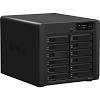The term RAID (initially Redundant Arrays of Inexpensive Disks, but now Redundant Arrays of Independent Disks) was first defined in 1987 by three researchers from the University of California. Their theory was that spreading data across multiple drives would not only improve system performance, but also reduce costs and lower power consumption.
Today, RAID is found in almost all enterprise storage devices, as well as in many high-capacity consumer devices.
How Does It Work?
While older storage devices used only one disk to store data, RAID storage uses multiple disks. Data can be mirrored on one or more of these disks in the same array, so that even if one disk fails, the data will be safe.
However, it is important to note that RAID is not a substitute for data backup, and IT experts advise utilizing a separate storage system for backup and disaster recovery.
Using a technique known a striping, RAID partitions each drive’s storage space into separate units of differing sizes, ranging from a single sector (512 bytes) to several megabytes.
RAID Storage Levels
There are different, numbered RAIDs, which store data in different ways. Although there are up to 10 different levels, these five are the most utilized:
* RAID 0 – Disk striping: Data is spread out across all the disks in the set. This improves performance, but does not offer high availability, as parity is not generated for RAID 0 disks. It requires at least two physical disks.
* RAID 1 – Disk mirroring: This requires at least two physical disks, which are essentially mirror images of each other. If one fails, the other is used to retrieve data. It is slow when writing to disks, as data has to be written twice, but it is fast for read operations.
* RAID 3 – This needs at least three physical disks and performs well under applications that need one long sequential transfer of data.
* RAID 5 – This is the most common method, using disk striping with parity. It offers a good balance between performance and availability.
* RAID 10 (from RAID 1 + RAID 0) – a combination of disk mirroring and disk striping, requiring at least four physical disks.
Mass Storage Systems Inc offers direct attached RAID solutions that are affordable and dependable. Find out about this and other data storage solutions at www.massmountain.com.







